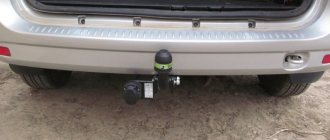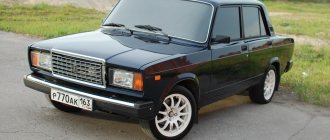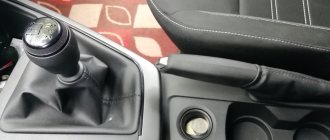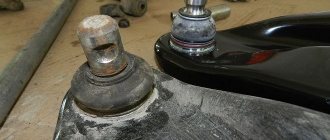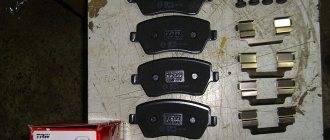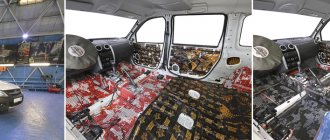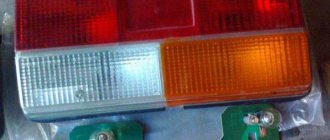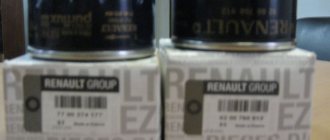In 2012, AvtoVAZ announced the start of production of a new small car, Lada Largus. The model is actually a version of the first generation Dacia Logan MCV for the domestic market. It is considered a joint project between AvtoVAZ and Renault, based on the B0 platform. In 2021, the car underwent a light facelift, as a result of which the radiator grille was updated, and the Lada nameplate was removed from the rear of the car. There were no serious modifications to the car. The basic idea was retained; the Polish car is quite popular and is in high demand among car enthusiasts. The model is equipped with a 1.6-liter gasoline engine. But we’ll tell you further what gearboxes are installed on the Lada Largus.
Manual gearboxes Lada Largus
From the very beginning of production, the car was equipped with a manual transmission-5. The transmission ensures optimal transmission of torque from the engine to the drive wheels. Depending on the engine power and torque, the Lada Largus is equipped with either JH 3 540 manual transmission or a similar JR 5 unit . The first type of manual transmission is designed for a 5-seater station wagon with a K7M engine under the hood. There are several versions of the JR5 mechanics:
- JR5551 – for a car with a 7-seater body and a K7M engine;
- JR5549 – for the version with a 5- and 7-seater body and with a K4M engine;
- JR5517 – for van with K4M and K7M engine.
The operating principle of the above units is almost identical and consists in connecting gears with different numbers of teeth. The main task is to ensure a change in torque in strict proportion to the gear ratio. There are several levels of boost for Lada Largus engines: 84, 87, 102, 105 and 106 horsepower. The different power of the motors is a consequence of the production of several modifications of the same 5-speed manual transmission with a certain number of teeth on the gears and gear ratio.
Which 5th gear gear is better to choose?
The table shows the car speed values at different gear ratios of Largus 5th gear, as well as the article number of the driven and driving gears:
Gear ratio 5th gear Catalog number 1 Catalog number 2 Speed at 3000 rpm Main gear 0.892 8200611295 8200608035 93.6 4.214 87.6 4.5 80.0 4.928 0.820 8200611299 8200607980 101.8 4.214 95.3 4.5 87, 0 4.928 0.795 8200611297 8200607978 105.0 4.214 98.3 4.5 89.8 4.928 0.756 8200611301 8200607981 110.4 4.214 103.4 4.5 94.4 4.928 0.738 8200611303 8200607983 113.1 4.214 105.9 4.5 96 .7 4.928
Design of 5-speed manual Lada Largus
Structurally, both manual transmissions on the Lada Largus are similar. They are based on a two-shaft design with synchronizers on all forward gears. This arrangement assumes the presence of two parallel shafts - driving and driven. When the vehicle is moving and the gear is changed from the input shaft gear, torque is transmitted to a specific gear on the driven shaft. This is the work of ordinary and simple mechanics, so the Lada Largus manual transmission does not have any special features. But there are still some differences JH 3 and JR 5 .
JH3 gearbox:
- the gears are switched on and off thanks to a clutch moving along a guide sleeve with a bearing;
- the gearbox is controlled by rigid traction;
- other gear ratios (1st gear – 3.72, 2nd gear – 2.04, 3rd gear – 1.39, 4th gear – 1.02, 5th gear – 0.79).
JR5 gearbox:
- The gearbox clutch is engaged and disengaged using a hydraulic slave cylinder;
- the gearbox is controlled by two flexible cables;
- other gear ratios (1st gear – 3.73, 2nd gear – 2.05, 3rd gear – 1.32, 4th gear – 0.97, 5th gear – 0.82).
The main advantage of the car's 5-speed manual transmission is its compactness. The housing of the unit is made of aluminum, inside of which there are shafts with a set of working gears. In order to ensure the best performance of the shafts, they were equipped with synchronization rings. The design also includes: a crankcase, a speed sensor, a control lever, a gear shift mechanism and other parts that are an integral part of a traditional manual transmission.
Possible breakdowns of Largus manual transmission
LADA Largus is a family vehicle equipped with a transmission system that is well suited to work in difficult road conditions and when traveling over rough terrain.
Since most malfunctions of this box occur as a result of wear of its component mechanisms, it is possible to replace a deformed component after disassembling the gearbox.
With prolonged use of the Lada Largus, its owner may encounter problems such as unclear gear shifts.
JH3 reliability
The JH3 gearbox is considered a reliable unit, therefore it is still relevant in the automotive market. Car owners prefer cars with a structurally simple gearbox, partly because of its accessible and cheap maintenance. The disadvantages of manual transmission boil down to the lack of a high level of driving comfort. The gear shift does not always occur clearly and quickly; sometimes there are jolts and jerking of the vehicle. Structurally, the unit has been fully studied, so even in the event of a serious breakdown, its overhaul will not be difficult. Usually the lever for switching from one speed to another becomes loose ahead of time, which leads to unclear switching.
Often, owners of Lada Largus with JH3 note the noisy operation of the manual transmission and a crunching sound when engaging reverse mode. Early wear of the synchronizers cannot be ruled out. If we close our eyes to some shortcomings, we will get decent mechanics that can go 200-300 thousand km without a single repair. There are known examples of cars that have covered about 500 thousand km on JH3 without a single repair. Much depends on your driving style and quality of service. The oil change must be carried out in accordance with the maintenance regulations.
Motors
Gradually, the “French” were replaced by the VAZ-11189 (8 valves, 87 hp) and VAZ-21129 (16 valves, 106 hp) engines. The cylinder block traces its history back to engine 21083. These engines are more powerful and more economical than French ones, but less reliable. The VAZ-21129 is equipped with hydraulic compensators; on some examples they knock loudly when warming up. Floating speeds and tripping can be caused by various reasons - from sensor glitches and deformation of the throttle valve ring to spark plug failure or clogged injectors. Burnout of valves happens, but is not a system problem. In general, the motors are well adapted to repair and last a long time.
All engines have a weak link - the thermostat, whose failures lead to “underheating” or overheating.
JR5 reliability
It’s difficult to praise the mechanical JR5 in any way, but there’s nothing particularly to reproach either. The unit itself is structurally simple, often hums, and the clarity of gear shifting leaves much to be desired. Over time, it requires overhaul or, in severe cases, replacement due to the destruction of key mechanisms. Often, car owners have to disassemble the box because the 5th speed refuses to turn off. The reason, as a rule, is the wear of the rear gear retaining spring. It can burst at any moment, and one of its fragments usually falls under the 5th speed fork. As a result, while driving, the driver realizes that the 5th speed does not turn off.
A roller bearing with a plastic cage on the secondary shaft is another weak point of the JR5 mechanics. The separator often falls apart even at short mileage, which leads to balls clumping together. At a minimum, the manual transmission starts to hum, but there have been cases when balls got caught between the gears. The deficiency was eliminated after the JR5 modernization. Many problems can be avoided if you follow the manual transmission maintenance regulations and use original oil. It is advisable to change the working material of the box every 50-60 thousand kilometers. Tranself TRJ 75 W -80 is suitable for replacement . After passing 10-15 thousand km, it is necessary to take control measurements of the fluid. In general, the box is old, moderately reliable, but not perfect. With the right approach it will last a long time and can be repaired without problems.
Replacing the fifth gear gear on Largus with your own hands
It is quite difficult to repair a gearbox with your own hands, so experts advise doing it at a service station. However, due to the design features of the gearbox and its location, replacing the 5th Largus gear can be done independently if you have certain skills and experience.
To do this, you must follow clear instructions:
- We put the car on a lift or hang it on stands.
- We remove the left front wheel and carefully, without breaking the clips and pistons, dismantle the engine compartment protection.
- Unscrew the upper fastening of the subframe bracket and move it to the side.
- We drain the oil from the crankcase by unscrewing the drain plug with a square wrench (it is advisable to tighten the plug after draining the oil).
- Remove the reverse sensor connector and the power steering mounting bracket.
- Unscrew the bolts securing the rear gearbox cover.
- We dismantle it, thereby opening access to the fifth gear gears.
Before you begin removing the gears, you need to secure them. To do this, pull the fork towards you and use a special mandrel to knock out the fixing pin. Then you need to return the fork to its original position and engage third gear, recessing the rod next to the fork. After this, pressing on the fork, we engage second gear - now the shafts are fixed.
In the final stage, loosen the bolt securing the gear on the secondary shaft, then unscrew the nut securing the gear on the input shaft, remove the retaining ring and unscrew the already loosened mounting bolt. We dismantle the fork along with the fifth gear clutch. Using a special puller, remove the drive gear, and similarly dismantle the gear on the secondary shaft. Having replaced a set of new gears with the desired gear ratio, we carry out the installation strictly in the reverse order.
It is important to remember that after installing all the removed parts, you should fill the gearbox with oil in accordance with the vehicle's operating instructions.
What is the result?
Mechanical boxes for Lada Largus are moderately reliable, low maintenance, and easy to repair. There shouldn’t be any problems finding a qualified automotive specialist capable of rebuilding a JH3 or JR5, even in a small city. You should not pay attention to the manufacturer’s statement regarding the maintenance-free manual transmission. Experts recommend changing the oil at least every 80 thousand km, ideally after 60 thousand km. If even minor malfunctions occur (knocking, crackling noises made by the gearbox, gears not engaging), you should immediately go to a service station for a comprehensive diagnosis. Timely minor repairs will prevent the development of a serious breakdown and will save the car owner’s time, nerves and money.
Lada Largus
Lada Largus
Manual transmission JH3
Manual transmission JR5
Tranself TRJ 75W-80 gear oil
edit this post
Gear ratios of Lada Largus gearboxes
Depending on the Largus configuration, the standard 5th gear ratios may be different. Comparisons of different modifications in the table:
| Equipment | Station wagon 5 seats K7M (1.6l, 8kl), JH3 540 | Station wagon 7 seats K7M (1.6l, 8kl), JR5 551 | Station wagon 5 and 7 seats K4M (1.6l, 16cl), JR5 549 | Van JR5 517 |
| 1st gear | 3,727 | |||
| 2nd gear | 2,048 | |||
| 3rd gear | 1,393 | 1,321 | 1,393 | 1,321 |
| 4th gear | 1,029 | 0,971 | 1,097 | 0,971 |
| 5th gear | 0,820 | 0,795 | 0,892 | 0,738 |
| Reverse | 3,545 | |||
| Main couple | 4,214 | 4,5 | 4,214 | 4,928 |
THREE FROM THE CASTER
Editorial "Largus" tried on three pairs of gears with different gear ratios. In addition to the standard fifth gear of 0.892, we sequentially installed sets of 0.820 and 0.795 (see table). On a 300-kilometer test route, including highways and suburban roads, they compared the difference in fuel consumption and accumulated subjective assessments, which are sometimes even more interesting for the car owner than measurement data. For reliability, the expert assessment was supported by measurements at the Dmitrovsky test site. Test results and comments are presented below, including photographs, tables and diagrams.
Features of the JH3 gearbox
The JH3 gearbox on the Lada includes a clutch housing, gearbox, and rear crankcase cover. Thanks to the clutch with a bearing located in the box, the clutch in the box is turned on and off. When changing speed modes, no extraneous noise is created. The Lada Largus gearbox provides the ability to accelerate quickly. The average working life of this box is approximately 250,000 km.
The gearbox control drive includes a rocker and a lever. It should be noted that there is a bevel differential. There is a drain plug at the bottom of the crankcase. It is controlled by a rigid rod. Its body is made of aluminum alloy. The JH3 540 version can be found in the five-seater Largus, which has an 8-valve engine.

